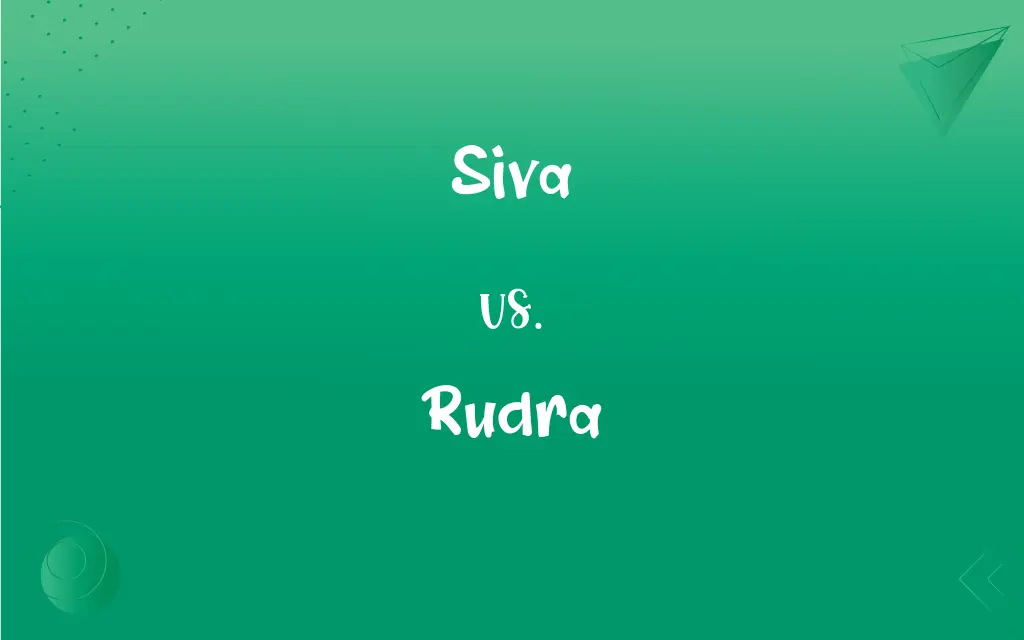Siva vs. Rudra: What's the Difference?
Edited by Aimie Carlson || By Harlon Moss || Published on February 12, 2024
Siva represents the benign, auspicious aspect, while Rudra symbolizes the fierce, destructive side.

Key Differences
Siva is often seen as a symbol of benevolence and grace in Hinduism, embodying qualities like meditation, compassion, and the arts. He is revered as the patron god of yoga, meditation, and the arts, embodying a peaceful, serene demeanor. Rudra, on the other hand, is depicted as a more fierce and aggressive aspect, often associated with storm, wind, and hunting. This depiction is more about destruction and chaos, representing the untamed and wild aspects of nature.
Siva is considered the destroyer and transformer within the Trimurti, the Hindu trinity that includes Brahma and Vishnu. He is responsible for the destruction of the universe, paving the way for its regeneration. This aspect of Siva indicates a cyclic process of creation, maintenance, and destruction. Rudra, in contrast, is initially mentioned in the Rigveda as a storm god and is associated with wrath and fury. He is often considered a more primitive or raw form of the later more benevolent and complex Siva.
In iconography, Siva is depicted in a calm, meditative state, with symbols like the crescent moon, the river Ganga flowing from his hair, and a blue throat (Neelkanth) from consuming poison during the churning of the ocean. This imagery underlines his role as a protector and purifier. Rudra, in contrast, is often shown as more fierce, sometimes with wild hair and a raging demeanor, embodying the ferociousness of a storm and the unpredictability of nature.
The followers and worship practices of Siva encompass a wide range, from ascetic yogis to householders, reflecting his role as a more universal deity. His worship involves rituals like the pouring of milk or water on the Shiva Lingam, meditation, and the chanting of mantras like "Om Namah Shivaya." Rudra, being an earlier Vedic deity, has more specific and ancient rituals, often involving offerings to appease his fierce nature and seek protection against calamities.
Philosophically, Siva is associated with Shaivism, one of the major traditions within Hinduism that reveres Siva as the Supreme Being. This tradition highlights his roles as creator, preserver, and destroyer, as well as his encompassing both good and evil, form and formlessness. Rudra, in earlier texts, is less a focus of a philosophical system and more an embodiment of natural forces and fear, requiring propitiation and respect.
ADVERTISEMENT
Comparison Chart
Symbolism
Benevolence, meditation
Fury, storm
Role in Trimurti
Destroyer, transformer
Primitive aspect of Siva
Iconography
Calm, meditative
Fierce, wild
Worship Practices
Diverse, universal
Specific, ancient
Philosophical Aspect
Supreme being in Shaivism
Embodiment of natural forces
ADVERTISEMENT
Siva and Rudra Definitions
Siva
Symbol of auspiciousness and benevolence in Hindu mythology.
The statue of Siva in his meditative pose radiates a sense of peace.
Rudra
An ancient Vedic deity associated with storms and hunting.
In the Vedas, Rudra is described as a fierce and powerful god.
Siva
Emblematic of the cosmic cycles of creation, preservation, and destruction.
In the cycle of life, Siva's role is to bring about transformation.
Rudra
Symbolic of nature's raw and untamed aspects.
The wildness of the storm is often likened to Rudra's ferocity.
Siva
A principal Hindu deity, the destroyer and transformer.
Devotees visit the temple to offer prayers to Siva during Mahashivratri.
Rudra
A precursor to the more complex deity Siva in later Hinduism.
Rudra in early texts is seen as a less refined form of what would become Siva.
Siva
A deity associated with the natural elements, especially the river Ganga.
The depiction of Siva with the Ganga flowing from his hair is iconic in Hindu art.
Rudra
Known for wrath and aggressive aspects in Hindu mythology.
The ancient hymns beseech Rudra for mercy and protection.
Siva
Representative of yoga and meditation in Hindu philosophy.
Practicing yogis often look to Siva as an ideal of spiritual discipline.
Rudra
Worshiped for protection against calamities and natural disasters.
Farmers would pray to Rudra to protect their crops from destructive storms.
Siva
Variant of Shiva.
Rudra
Father of the storm gods Marut; controller of nature; sometimes identified with Siva
Siva
One of the triad of Hindoo gods. He is the avenger or destroyer, and in modern worship symbolizes the reproductive power of nature.
Siva
The Destroyer; one of the three major divinities in the later Hindu pantheon
FAQs
What are the common symbols associated with Siva?
Common symbols include the trident (Trishula), crescent moon, the Ganga river, and the blue throat from consuming poison.
How is Rudra depicted in Hindu texts?
Rudra is depicted as a fierce deity, associated with storms, wind, and hunting, often seen as a precursor to the more developed deity Siva.
What role does Siva play in the cycle of creation?
Siva plays the role of the transformer, responsible for the destruction that precedes rebirth and renewal in the cosmic cycle.
Can Rudra be considered a wrathful form of Siva?
Rudra can be seen as an aspect of Siva, representing his more fierce and untamed nature.
Is Siva the same as Rudra?
Siva and Rudra are related but distinct; Rudra is an earlier Vedic deity representing storm and fury, while Siva is a more complex deity encompassing both destructive and benevolent aspects.
What is the significance of the Shiva Lingam in worship?
The Shiva Lingam represents the formless nature of Siva and is a central symbol in his worship, embodying his creative and destructive powers.
Why is Siva referred to as the destroyer?
Siva is called the destroyer as part of the Hindu trinity (Trimurti) for his role in destroying the universe to allow for its regeneration and renewal.
Are there any specific mantras associated with Rudra?
The 'Rudram' is a Vedic hymn dedicated to Rudra, invoking his blessings and protection.
What does the crescent moon on Siva’s head symbolize?
The crescent moon symbolizes the cyclical nature of time and Siva’s control over the mind and time.
What is the meaning of 'Neelkanth' associated with Siva?
'Neelkanth' refers to Siva's blue throat, acquired when he consumed poison during the churning of the ocean to save the world.
What are some common offerings in Siva worship?
Common offerings include milk, water, bael leaves, and flowers, especially during the ritual of Abhishekam.
Are there any festivals dedicated to Siva?
Yes, Mahashivratri is a major festival celebrating Siva, marked by fasting, chanting, and night vigils.
How is Siva's role different from Vishnu's in Hinduism?
While Siva is the destroyer and transformer, Vishnu is the preserver, maintaining the order and harmony of the universe.
How does Shaivism view Siva?
In Shaivism, Siva is viewed as the Supreme Being, encompassing creation, protection, and destruction.
What is the significance of Siva's third eye?
Siva's third eye represents wisdom, insight, and the ability to see beyond the obvious.
What are the origins of Rudra in Hindu mythology?
Rudra originates from the Rigveda, one of the oldest Hindu texts, where he is a god of storms and the hunt.
How is Siva represented in dance and art?
Siva is often depicted as Nataraja, the lord of dance, symbolizing the cosmic dance of creation and destruction.
Is Rudra worshiped separately from Siva?
In early Vedic times, Rudra was worshiped separately, but in later Hinduism, he is largely assimilated into the figure of Siva.
Can Rudra be seen as a protector?
Yes, in some aspects, Rudra is invoked for protection against natural disasters and to appease his wrathful nature.
What is the role of meditation in Siva worship?
Meditation is central to Siva worship, reflecting his association with yogic practices and inner peace.
About Author
Written by
Harlon MossHarlon is a seasoned quality moderator and accomplished content writer for Difference Wiki. An alumnus of the prestigious University of California, he earned his degree in Computer Science. Leveraging his academic background, Harlon brings a meticulous and informed perspective to his work, ensuring content accuracy and excellence.
Edited by
Aimie CarlsonAimie Carlson, holding a master's degree in English literature, is a fervent English language enthusiast. She lends her writing talents to Difference Wiki, a prominent website that specializes in comparisons, offering readers insightful analyses that both captivate and inform.







































































